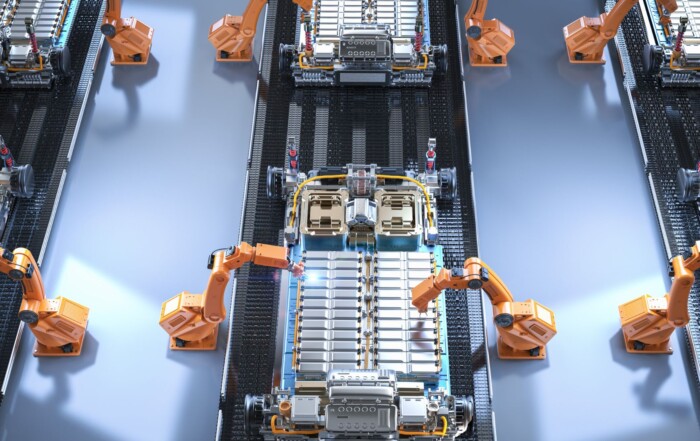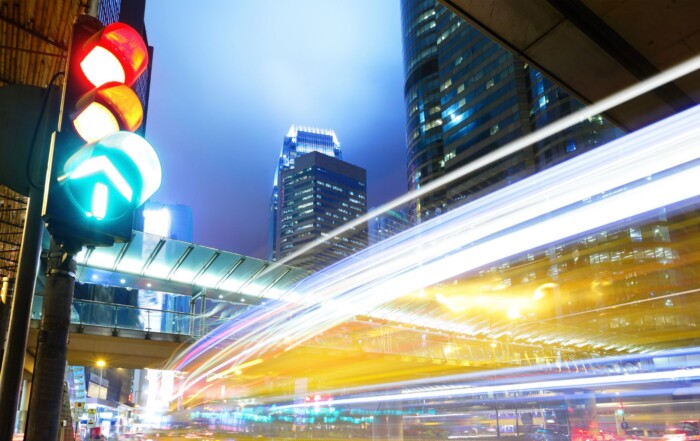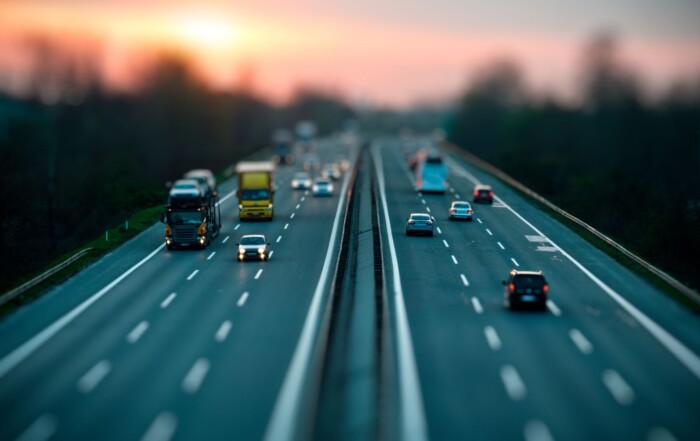Green (radar) wave with smart systems for traffic light control.
Traffic light switching adapted to traffic conditions for efficient intersection management.
Nobody likes to wait at traffic lights. Especially in urban centres, journeys take longer due to traffic jams at intersections. So a lot of patience is needed during rush hour. Their engines are running, but the cars aren’t budging. In order to cut back the resulting exhaust gases and waiting time, traffic management optimises traffic light switching. But how is it decided who has a red light and how long a traffic light phase lasts? Where does the necessary traffic information come from? What technologies are used for this purpose? In this blog article, you will find out more about systems for traffic detection and radar technology for traffic light control.
Programming & data collection
At intersections, usually standardised processes and times usually regulate the switching of traffic lights. For a green wave, this programming is sometimes coordinated between several intersections and an optimum driving speed is specified. Regular vehicle counting can be used to determine peak times and main traffic routes. This complex method can be used to draw conclusions about general traffic volumes.
However, the default settings are not efficient. The programming does not react flexibly if a given traffic situation deviates from the average values. If the road is hardly driven on at night, it would be inappropriate to utilise the same traffic light program as for rush hour traffic. While the traffic lights are off at some small intersections, this would be too unsafe for confusing, large ones.
Another problem is when mobile traffic lights temporarily regulate traffic. For example, at construction sites where it is only possible to drive through in one direction. The necessary data sets are lacking due to changes in the traffic flow. Or the intersection’s standard program does not fit the temporary traffic situation.
Traffic light control adapted to needs with technical support
For this reason, traffic management does not rely solely on counting vehicles and data from past experience. At the intersection, the installation of technological assistants has proved highly valuable – they provide information about the current situation on site and enable more demand-oriented traffic light control.
A prerequisite for this is for road users to be detected. Therefore, cameras or induction loops are often found at intersections. The two technologies differ not only in how they work, but also in how they can be used.
Contact loops in the asphalt
The induction loop is embedded in the road surface or installed under it. By means of electromagnetic induction, the technology selectively detects metallic vehicles that stop over the cable harnesses laid in the road. The direct proximity of a metallic object changes the parameters of the induction loop. The cable loops transmit the information about the presence of a vehicle to the traffic light control system. With this technology, vehicle detection is only possible directly at the positions of the sensors. It is possible to determine the vehicle type and count vehicles at the spot of the induction loop with appropriate data analysis. Some induction loops use a specific frequency to give priority to ambulances with a specially configured signal system.
The loops cannot be installed without a construction site, as existing roads must be ripped open and re-tarred. Vehicles that are not detected by the ground sensor don’t trigger the traffic light to switch. Detection is usually dependent on the sensitivity, which is primarily optimised for motor vehicles.
Traffic cameras
Video technology can be found at numerous intersections and stretches of road in many countries. The cameras monitor what is happening on site and provide visual images. Sometimes software algorithms are also used to detect individual vehicles and certain events or to determine specific data. In Germany, the video cameras are mostly used to assess the traffic situation. Technical traffic management utilises the image transmission, among other things, to identify traffic congestion and to pass on this information to public communication centres (such as radio stations) as a warning. The webcam transmissions are used to optimise traffic. Data sets are usually not stored due to the servers and storage space required for data processing. Nevertheless, video surveillance is often criticised due to its lack of anonymity. Number plates and even people can be identified without significant pixelation or filtering. Currently in Europe, however, the use of such cameras is very limited. Another disadvantage of traffic cameras is how quickly they get dirty and the associated maintenance work. Animals moving in front of the lens, dirt, or even raindrops and ice can make the transmitted image unusable.
Rarely used: infrared
Another technology for vehicle detection is the thermal imaging camera. These infrared sensors are in use particularly in the USA and have some pitfalls. For example, they can easily be manipulated through the installation of an infrared transmitter in the vehicle. Originally intended to enable green phases for emergency vehicles and the police, in the USA everyday people have also managed to equip their private cars with these kinds of mobile devices. In addition, due to their technical properties, infrared cameras struggle at extreme temperatures, with resolution, and with heat-insulating materials.
Radar is predestined for the traffic sector
The demands in the field of transport technology are on the rise. The technology is supposed to take on more tasks and be more automated and precise in order to enable efficient traffic management. Advanced systems are in demand that pave the way for smart cities, while saving time and cutting CO2 emissions.
Radar is a promising technology. From conventional radar traps to digital speed displays – its advantageous properties have helped firmly establish the technology in the transport sector for many years. It is predestined for traffic monitoring and has great potential for development. The sensor technology is robust and precise. It works no matter the weather and light conditions and tolerates extreme heat or cold. Dirt does not interfere with detection.
Another one of the technology’s advantages is its great functionality. Radar enables more than just vehicles to be recognisable or countable. This measurement technology enables extensive data about road users to be collected anonymously. It can record, for example, information about speed, direction of movement, angular position, and distance. Advanced radar systems also boast many advantages for traffic light control.
How traffic light control via radar works
Modern radar systems are mounted on traffic light poles. The radar beam is oriented forward to cover the largest-possible space in the intersection area. The antennas usually face down onto the street. They boast a long range for recording long stretches of the road and to detect approaching vehicles early.
Radars emit electromagnetic waves that hit vehicles and bounce back. The antennas then receive a response signal consisting of numerous detection points. This raw data is characterised by various measurement effects. Without subsequent signal processing, the output cannot be used to control traffic lights. With advanced systems, a unit and software are usually available for further analysis.
In order to obtain the desired measurement data and specific object information, the individual detections are filtered and assessed, and the data is processed. One of the methods used for this is clustering. With it, the signal processing unit bundles individual points that belong together based on their values to form an object target. To distinguish between multiple objects, radar utilises multiple transmitting and receiving antennas and conducts measurements in different dimensions. The systems thus have a high resolution for distinguishing objects. Algorithms also enable the target to be tracked and movement history to be displayed. Radar systems use defined measured values (e.g. radar cross-section) to sort objects into a specific vehicle category. This measurement method also provides object information such as speed, distance, direction of motion, and angular position. These features allow road users to be positioned and observed and even which lane they are in to be determined.
After a further processing step is taken, the extensive real-time data can be used to provide information about the occurrence of certain events. For this purpose, conditions are defined in the radar system software. For example, the traffic management can configure a clear signal to be emitted in a freely definable zone within the large coverage area as soon as the desired condition occurs. Typical scenarios are when a stop line is driven over, a car is driving in the wrong direction, or cars are standing in the intersection or emergency lane. Radar also covers the detection of high traffic volumes by counting and detecting moving vehicles and vehicles standing at the intersection in real time (as with an induction loop).
If traffic light control is to be automated on site, the radar transmits the processed information and events to the traffic light control unit. Subsequently, the received signals are translated into a switching pulse which the traffic light’s relays can understand and act upon.
Transmitting the radar data to a control centre in addition results in slight latencies. For this reason, traffic lights are usually controlled locally and not remotely. Information forwarded to traffic management is used, for example, to provide statistics on and analyses of traffic events.
Challenges presented by radar sensors
Radar boasts tremendous functionality for traffic light control compared to infrared and induction. Simple radar-based motion detectors do not fully meet the high demands of efficient traffic management at major traffic hubs and leave something to be desired. The more the radar contributes to controlling traffic lights, the more accurate and reliable the device has to be. High performance requires state-of-the-art technology and components.
The advanced systems need high measurement accuracy, very good resolution, and a large field of view to capture many vehicles at the same time. To achieve this, several antennas need to be combined. This results in multi-path effects that can cause erroneous detections. Antenna design and signal processing have to reduce this problem to a minimum. Radar detection is very sensitive in order to perform high-precision measurements – meaning irrelevant detections must be filtered accordingly. One example is the rain filter.
Tracking road users while providing the other features for demand-oriented traffic light control make signal processing challenging. During development, innovative technology and expertise is required to process the detected data. Generally, in addition to the necessary development work, expensive components are required to enable strong performance. One challenge traffic radar thus faces is to be able to offer the systems at an attractive market price.
An additional problem stems from using several radar components in close proximity, as the devices may interfere with each other. Interference can be avoided by optimally coordinating frequencies and implementing appropriate signal processing.
The future of traffic light control is on our radar
These challenges the technology presents by no means rule out using it for traffic light control. Radar systems boast many advantages over camera, induction, and infrared. Advanced systems whose performance is not impaired by the usual difficulties are already available on the market today.
Examples of this include the iSYS-5220 and ITR-3810 radar systems from InnoSenT GmbH. The additional value traffic radars provide through their sophisticated technology and cost optimisation sets them apart from competing sensor equipment. In the coming years, we can expect to see further development on radar systems used in the transport sector to continue to be on the rise. The reasons for this are wide-ranging. For one thing, technological progress is advancing rapidly in the areas of software development, data processing, and data storage. For another thing, the prices of the components are dropping over time. What’s more, the release of additional frequencies for this use case should yield further improvements in precision.
This means there’s hardly any way around using this sensor technology for efficient traffic light control in smart cities. Radar developers are keeping close track of transport technology’s future.
Picture Source: Leung Cho Pan von Canva.com
Share this Content
Radar for Traffic Applications
Reliable vehicle detection with traffic radars
In transport, radar technology boasts a wide variety of applications. Radar is predestined for transport monitoring and has been established for many years as an outstanding technology solution in the traffic sector. A typical example is police radar traps. However, also more complex applications such as traffic assessment and statistics for intersection management can be achieved using radar-based vehicle detection.


